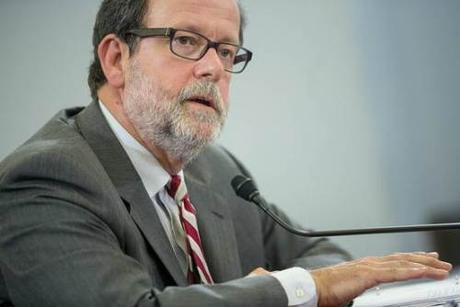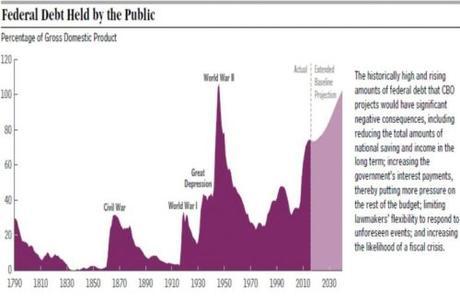
CBO Director Keith Hall has a dire warning…
CNSNews: Testifying in the U.S Senate on Thursday, Congressional Budget Office Director Keith Hall warned that the publicly held debt of the U.S. government, when measured as a percentage of Gross Domestic Product, is headed toward a level the United States has seen only once in its history—at the end of World War II.
To simply contain the debt at the high historical level where it currently sits—74 percent of GDP–would require either significant increases in federal tax revenue or decreases in non-interest federal spending (or a combination of the two).
Historically, U.S. government debt held by the public, measured as a percentage of GDP, hit its peak in 1945 and 1946, when it was 104 percent and 106 percent of GDP respectively.
In 2015, the CBO estimates that the U.S. government debt held by the public will be 74 percent of GDP. That is higher than the 69-percent-of-GDP debt the U.S. government had in 1943—the second year after Pearl Harbor.
By 2039, CBO projects, the debt held by the public will increase to 101 percent of GDP and by 2040 to 103 percent GDP. At that point, Hall told the Senate Homeland Security and Governmental Affairs Committee, the “debt would still be on an upward path relative to the size of the economy.”
The U.S. Treasury divides the federal debt into two main parts: debt held by the public and intragovernmental debt. The debt held by the public includes Treasury securities such as Treasury bills, notes and bonds that are owned by individuals, domestic and foreign corporations, private banks, the Federal Reserve Bank, and foreign governments. The Treasury pays interest on this debt to those who own it. The intragovernmental debt is money the Treasury owes to government trust funds–such as the Social Security trust funds–because the government has spent money belonging to those trust funds (i.e. Social Security payroll taxes) on things other than what the trust fund was created to fund (i.e. Social Security).
As of July 9, according to the Treasury, the debt held by the public was $13,102,609,587,775 and the intragovernmental debt was $5,049,321,696,720. That equaled a total debt of $18,151,931,284,495 (and counting).
While the run up in debt held by the public as a percentage of GDP in the 1940s financed a global war against Nazi Germany and Japan that ended with an allied victory, the current run toward unprecedented debt is based on projected increases in mandatory federal spending for entitlement programs. These include Social Security, Medicare, Medicaid and Obamacare subsidies.
“Mainly because of the aging of the population and rising health care costs, the extended baseline projections show revenues that fall well short of spending over the long term, producing a substantial imbalance in the federal budget,” Hall said in his written testimony.
“As a result, budget deficits are projected to rise steadily and, by 2040, to raise federal debt held by the public to a percentage of GDP seen at only one previous time in U.S. history—the final year of World War II and the following year,” he said.
“Moreover,” he said, “debt would still be on an upward path relative to the size of the economy. Consequently, the policy changes needed to reduce debt to any given amount would become larger and larger over time. The rising debt could not be sustained indefinitely; the government’s creditors would eventually begin to doubt its ability to cut spending or raise revenues by enough to pay its debt obligations, forcing the government to pay much higher interest rates to borrow money.”
Eventually, the nation would face a crisis—with wary investors demanding “much higher interest” rates to buy U.S. government debt.
“How long the nation could sustain such growth in federal debt is impossible to predict with any confidence,’ testified Hall. “At some point, investors would begin to doubt the government’s willingness or ability to meet its debt obligations, requiring it to pay much higher interest costs in order to continue borrowing money. “Such a fiscal crisis would present policymakers with extremely difficult choices and would probably have a substantial negative impact on the country,” he said.

“Unfortunately, there is no way to predict confidently whether or when such a fiscal crisis might occur in the United States,” he said. “In particular, as the debt-to-GDP ratio rises, there is no identifiable point indicating that a crisis is likely or imminent. But all else being equal, the larger a government’s debt, the greater the risk of a fiscal crisis.”
Simply keeping the debt in check would require significant changes in federal policy that would hit Americans in the pocketbook. “Just holding federal debt at its current high level of 74 percent of GDP in 2040 would require significant changes in tax and spending policies,” Hall testified. “The combinations of increases in federal tax revenues and cuts in non-interest federal spending relative to current law of about 1.1% of GDP in each year for 25 years would be needed.
“In 2016, this would be a spending and/or a tax revenue increase totaling about $210 billion dollars–and then more than that in each year after that,” said Hall. “If those changes came from increases of equal percentage in all types of revenues they would represent an increase of 6 percent relative to current law for each year between 2016 and 2040,” Hall testified.
“In 2016, for example, an average middle-income household would have to pay $750 more in taxes and more than that in each year afterwards,” he said. “Or if the changes came from cuts of equal percentage in all types of non-interest spending, that spending each year would have to be 5.5 percent less than projected,” he said. “If the reduction was applied across the board to all types of non-interest spending, an average 65 years old in the middle of the earnings income who retires in 2016 would see a reduction of about $1,050 in his or her initial annual Social Security benefits—more than that in each year afterwards.”
“The more ambitious goal of returning public debt by 2040 to its average level over the past half century, which is 38 percent of GDP, would require more than that,” Hall said. “This would require a revenue increase and/or non-interest spending decrease totaling 2.6 percent of GDP every years.
“This means an average middle income household would have to pay $1,700 more in federal taxes in 2016 and larger amounts in subsequent years,” he said. “Or by cutting non-interest spending across the board, average Social Security benefits for a 65-year-old in the middle of the earnings distribution would have to drop by $2,400 in 2016 and by larger amounts in later years.”

DCG

